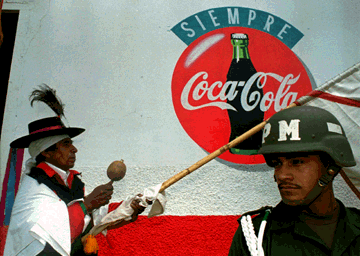Jan
27
Menage a trois? Tradition, Modernity and Memory
Posted by: Brian | January 27, 2009 | Comments Off on Menage a trois? Tradition, Modernity and Memory
Even after the class discussion, I still feel as though I am plodding aimlessly through “The Faces of Popular Culture”. The only way I am able to make sense of everything that Rowe and Shelling cover is to view popular culture in latin america as an improvised duet. An improvised duet between tradition and modernity regulated by state, commercial and a population’s interests (even the best improvisations are regulated or have guidelines). To complicate matters is the idea of the preservation of memory which guards tradition, and provides a springboard for further modernization, by now, with tradition, modernity and memory (or history), things are looking a little more spontaneous, a little less orthodox, and definitely a little more a figurative menage a trois.
The mention of pacha kuti in the context of “turning upside down and inside out of time and space” can be seen as a parallel for the irregular power relations between tradition, modernity and memory. Such power relations can also be seen as a courtship where the rural (tradition) and the urban (modernity) collide, compromise, and eventually produce elements of popular culture. This mostly symbiotic relationship was illustrated with many examples…
“peasants consume industrial products and there is demand for artesanias in the cities”
In this case, the peasants represent the rural (traditional), the industrial products and the cities represent the urban (modern), and ultimately, the demand for artesanias can be seen as the preservation of tradition, and thus the persistence of memory, since the articrafts they produce are the visual culminations of a history deeply rooted in specific ceramic and artistic styles.
The interplay of rural and urban is presented in a concrete manner in the discussion of festivities, “rural festivals become urban festivals…where elements become a representation of national rather than local identity”. By publishing the ‘elements’ as depictions of national identity, the local identity is also enveloped and represented on a more accessible level (nationally), the rural festival elements are metamorphosed, embraced by the nation, and consequently, preserved by the targeting to a wider population. By allowing more people access to elements of the festivals they can identify with, the history of those festivals are embedded into a naon’s cultural heritage, and also into the memory of its people.
Finally the example of the radio which “simultaneously validates the migrants’ rural cultural identity, while also promoting their participation in the urban context” further supports the relations of traditions, modernity, and memory (where the radio is a medium through which the memory of those traditions can be prolonged and protected).
I was appreciative of Rowe and Shelling’s decision to map the traditional and modern in terms of rural and urban, since the contrast between those two spaces represents the changes in culture and the perpetuation of certain cultural elements.
